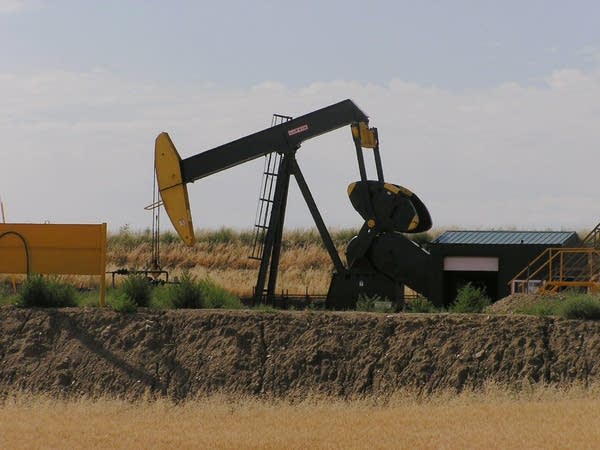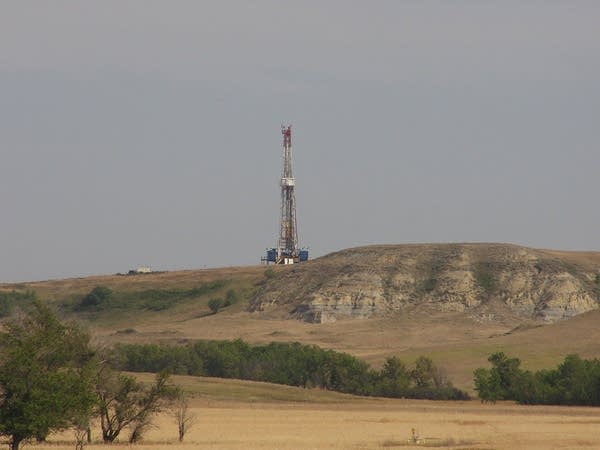North Dakota oil patch is booming
Go Deeper.
Create an account or log in to save stories.
Like this?
Thanks for liking this story! We have added it to a list of your favorite stories.

Al Golden has been looking for oil in North Dakota since 1953. His eyes still light up when he remembers the first time oil gushed from one of his wells.

"It sends chills and thrills and prickles up and down your spine, and you think you must have died and gone to heaven," says Golden.
But Golden also recalls that after that gusher, he drilled 21 straight dry holes.
"I've had some terrible disappointments. Drilled a well right in the center of four wells. It was what we call a gut-shot cinch. A can't miss kind of deal," says Golden. "I was horribly disappointed."
Turn Up Your Support
MPR News helps you turn down the noise and build shared understanding. Turn up your support for this public resource and keep trusted journalism accessible to all.
Al Golden's story is the story of North Dakota oil. Boom and bust.
All indications are that we are going to be challenged to meet the world demand for oil and gas.
Western North Dakota has large oil reserves. By some estimates, it has more oil than the Arctic National Wildlife Refuge. A federal government geologist estimated a formation called the Bakken shale holds 400 billion barrels of oil.
Ron Ness, president of the North Dakota Petroleum Council, says that number is only a guess at this point, but it's still generating a lot of excitement.
"Even if it's a percentage of a percentage of a percentage of 400 billion barrels of resource, that's a big number," says Ness. "What's recoverable of that resource is the important number."
And getting that oil out of the ground is a challenge, because the oil is expensive to extract from shale nearly two miles deep.
When world oil prices are high, it's profitable. When the price of oil falls, the North Dakota wells shut down.
But many in the industry think there's been a fundamental change that will stabilize North Dakota oil production. Improved technology makes it easier to capture the oil, and world oil prices are expected to stay high.

Hess Corp. is drilling a new well near Tioga, not far from where North Dakota's first successful oil well was drilled in 1951. It's one of nearly 40 rigs now drilling for oil in North Dakota.
Hess production superintendent Virgil Miller says he's not expecting a bust at the end of this oil boom.
"It might slow down a little bit, but I think it's going to be viable in the long term," says Miller. "Nobody thinks the price is going to go down that far. It's going to stay above $50 (per barrel), probably."
This well is an example of the new technology that helps make North Dakota oil profitable.

The oil is in a layer of rock about two miles below the surface. But that layer is thin, perhaps five to 20 feet thick. So this rig drills down two miles, then gradually turns using a steerable drill bit, until it's drilling horizontally. It then bores through the rock layer for a mile. That increases the efficiency of oil extraction.
Bryce Hauge is monitoring several computer screens in the air-conditioned control room. He keeps tabs on the drill bit, about the size of a bowling ball, chewing through rock nearly three miles away in, temperatures more than 200 degrees Fahrenheit.
"We have tools down hole telling us where we're at," says Hauge. "Every 30 feet we take a survey. And they claim they can put a bit in a five-gallon bucket nowadays, and I kind of believe it, actually."
Hauge has been working in the oil fields since the last boom in the 1980s. He jokingly says what he likes best about the job are paydays and days off.

"No, it's an interesting job," says Hauge. "I was 17 years old when I started. It's good money. You're outside. It's healthy, fresh air. Lots of exercise. Great people to work around."
Finding enough people like Bryce Hauge is probably one of biggest challenges facing the industry. Despite high pay, not enough young people are interested in what's been an on-again, off-again industry.
Industry officials say each oil rig directly and indirectly generates about 120 jobs. Finding housing for those workers is another challenge.
Many investors built apartments in places like Williston in the 1980s. A couple years later the industry collapsed, and those buildings were empty. Many local developers are not eager to jump on another oil boom.
But some oil industry giants are betting on North Dakota oil reserves. Marathon Oil recently announced it will spend $1.5 billion to drill 300 new wells in the next five years.

Steve Guidry, a regional vice president at Marathon, says in the next 13 years oil demand will grow by 55 million barrels a day, or nearly 20 percent.
"Finding that additional supply is equivalent to finding five and a half Saudi Arabias," says Guidry. "So when you talk about do we think the new price scenario is sustainable, one has to recognize on the global scale, all indications are that we are going to be challenged to meet the world demand for oil and gas."
North Dakota officials estimate they will approve permits for 500 new oil wells this year. All that activity means more oil revenue, which means a healthy surplus for state government. The oil tax brought in $170 million last year. Oil revenue is expected to be at least $300 million next year.
Dear reader,
Political debates with family or friends can get heated. But what if there was a way to handle them better?
You can learn how to have civil political conversations with our new e-book!
Download our free e-book, Talking Sense: Have Hard Political Conversations, Better, and learn how to talk without the tension.





